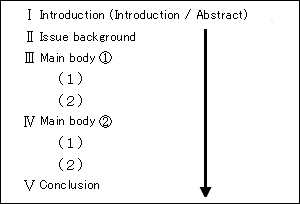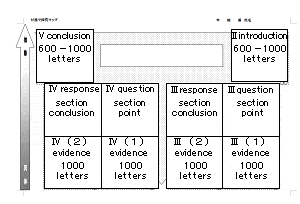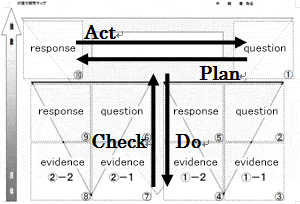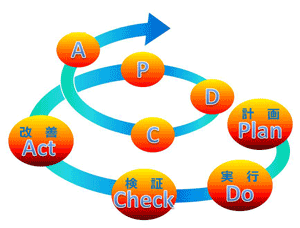Top>Education>Thesis outline creation for high school students ―”Research Map” with sticky notes―
 Index
Index

Yu Saito [profile]
Thesis outline creation for high school students
―”Research Map” with sticky notes―
Yu Saito
Japanese teacher at Chuo University Suginami High School
1. High school student graduation reports and outlines
2015 marks the 12th year since Chuo University Suginami High School (hereafter our school) started giving instruction for graduation thesis. There have been many essay topics set by the students so far (see our homepage![]() to see a past graduation thesis topics). As previously mentioned on CHUO-ONLINE
to see a past graduation thesis topics). As previously mentioned on CHUO-ONLINE![]() , if properly trained, even high school students can produce consistent theses. Of course they cannot write them straight away. Our school developed the “research map” as a tool for thinking. The original “research map” has evolved from an A4 size form to a 75mm x 75mm (roughly business card size) shape using adhesive sticky notes (figure 2).
, if properly trained, even high school students can produce consistent theses. Of course they cannot write them straight away. Our school developed the “research map” as a tool for thinking. The original “research map” has evolved from an A4 size form to a 75mm x 75mm (roughly business card size) shape using adhesive sticky notes (figure 2).
Now, in order to write a thesis, you must form an outline that becomes the framework of the argument, but most high school students cannot form this outline. Why can’t high school students form an outline? The reason is, that to most high students, an outline is nothing more than a simple “table of contents” linking to the topic. An outline is not a “table of contents”, but a “blueprint” of the thesis. When given academic guidance after entering university, they can see the structured framework as an argument. However, in the case of high school students, they only see the list of topics in a linear fashion even though the topics are parallel (figure 1). This being the case, it is better to show high school students, who plan to write their first theses, outlines as a structure like our “research map”, rather than as something linear (figure 2).

Figure 1. General outline

Figure 2. “Research map” outline (A3 size)
In the case of high school students, when they write theses to expand an outline as shown in figure 1, I can confidently say that the introduction and conclusion do not match each other. As they write their theses, they digress from the arguments, and the theme of the thesis becomes totally different unnoticeably. However, as shown in figure 2, if the evidence is displayed in a structured manner from the beginning, it becomes difficult to veer off course. It is important not to start writing straight away, but to strategically think about the content you will write about at the start. In the research map, by following steps 1-10 (figure 2), you can create a structured outline without noticing it. Also, while writing the essay, if you forget where you are at, you can return to the research map and get back on track. By organizing abstract ideas into vertical and horizontal axes from a bird’s eye view on the research map, you can notice the discrepancies.
2.“Research Map” and outline
Each sticky note on the research map corresponds to the construction of each section of the thesis. For this reason, as a rule, our students write their theses in a 5 section structure as shown below (figure 3).

Figure 3 Correspondence of “Research Map” and section structure of thesis
Based on figure 3 above, the section structure of the thesis (outline) will be as follows.
Ⅰ. Abstract (Summary of the thesis)
Ⅱ. Issue background and setting of the issue (Introduction)
Ⅲ. Observations based on ”evidence (1)” (Main body (1))
Ⅳ. Observations based on ”evidence (2)” (Main body (2))
Ⅴ. Argument and summary of observations (Conclusion)
At first glance this outline may resemble the general outline shown above (figure 1), but when considered from the viewpoint of the writer, that there is a table of contents based on the outline as a structure (figure 2) is important. Because Outline I, which is not in figure 3, becomes the abstract displaying the overall evidence, the content of sticky notes 1-10 are written concisely (400-600 letters). Also, if the above notes are transferred to flip cards or slides, they can be used for various types of presentations.
3. PDCA Cycle
We can explain the creation process of the “Research Map” with the PDCA cycle. What is indispensable to inquiry learning is updating the “question”, “response” and “evidence” numerous times. In that meaning, the inquiry cycle surrounding the “question”, “response” and “evidence” can be called the PDCA cycle.
Regarding the research field students initially take on, they prepare a set (Plan) of “questions” (proposing an issue) and “responses” (hypothesis to be argued). While gathering necessary information and examples that become the basis of the argument in order to prove the validity of the Plan, and writing the key points of the examples on the sticky notes, the sticky notes are organized while comparing, sorting and linking them (Do). Once the overall evidence is put together, the relationship between the sticky notes, especially the consistency of the “responses” and “evidence” is verified (Check). Finally, the overall argument is reviewed based on the results of the verification, on top of sorting out the necessary and unnecessary information, the “questions” are refreshed while adding anew essential elements to areas that are insufficient (Act). Exemplifying the process of rearranging and replacing sticky notes on the “Research Map” like this is nothing more than repeating the PDCA cycle necessary for creating a research plan (figures 4 and 5).

Figure 4 “Research Map” and PDCA Cycle

Figure 5 PDCA Cycle image
4. Sticky notes and pencils over ICT
In response to the question “How did you feel using the Research Map?” in a survey for the students after writing their graduation theses, many students gave positive comments. Among those responses, “the Research Map was the most important step in writing the thesis. I think the thesis would have been difficult to write without it” shows the importance of the process of trial and error before “writing”, in other words, “thinking”.
Educational principles and teaching methods that are seen as different from practical education up until now, such as inquiry learning and active learning, have been gaining attention in recent years. However, these education principles and teaching methods are not different so much from the great amount of accumulated practical education that has been produced in school education. Some people need the introduction of ICT, but we should be cautious not to make that method a goal. Should we start with lessons that delve into essential thinking, starting with notes and pencils?
References
- Terumi Kuwata et al. (2010) Shikouryoku no Kitaekata – Gakkou Toshokan to Tsukuru Atarashii “Kotoba” no Jugyou (Strengthening Thinking Power – School Libraries and Lessons Creating New “Words”), ITSC
- Yuki Hatta & Hisanobu Watanabe (2013) Tankyuu wo Michibiku “Toi” wo Settei Suru Nouryoku no Ikusei – Koukou Kokugoka Gendaibun “Kokoro” no Jugyou wo Tooshite (2) (Nurturing Skills to Set “Questions” Leading to Research – Through Demonstration Lessons of “Kokoro”, High School Japanese Contemporary Writing (2)), University of Fukui Graduate School “Kyoushi Kyouiku Kenkyuu Vol. 6)
- Masaharu Kato (2003) Kougu – Kangaeru Tame no Dougu, Motte Imasu Ka? (Thinking Tools – Do You Possess the Tools for Thinking) CCC Media House
- Yoshifumi Goto, Shiori Ito & Yoko Noborimoto (2014) Manabi no Waza – 14sai Kara no Tankyuu, Ronbun, Purezenteeshon (Learning Skills – Research, Essays, Presentations From 14) Tamagawa University Press
- Toulmin, Stephen E.(1958) The Uses of Argument, Cambridge Univ. Press.
-
Yu Saito
Japanese teacher at Chuo University Suginami High School - Yu Saito was born in 1975. He graduated from the Faculty of Education, Tokyo Gakugei University. He started his current position in 2005 after working as a part time instructor at Chuo University Suginami High School. He is a contract researcher of the Education Institute for Private Schools in Japan from 2006 to 2007. He is also Tokyo Private School Education Research Institute research cooperation school researcher representative from 2008 to 2009. He has been a Sanseido high school Japanese textbook editorial committee member since 2009. His major publications include Media Riterashii Ikusei no Tame no Ronbun Shidou to Jissen (Essay Instruction and Practice for Nurturing Media Literacy) (coauthor, Tokyo Private School Education Research Institute “Kiyo” Vol. 57), “Kyouzai” Toshite Yomu Medoruma Shun “Tamashi Kome” (Reading Shun Medoruma’s “Tamashi Kome” as “Teaching Material” (Tokyo Gakugei University “Kokugo Kokubungaku” No.40), and “Kokkyou no Minami, Taiyou no Nishi” Saidoku – Kongen Toshite no Riaru (Rereading “South of the Border, West of the Sun” – The Real Roots ( “Haruki Murakami and the 1990s”, edited by Takeshi Usami & Hiroyuki Chida, included in Ohfu, 2012).
- Research Activities as a Member of Research Fellowship for Young Scientists (DC1), Japan Society for the Promotion of Science (JSPS) Shuma Tsurumi
- Important Factors for Innovation in Payment Services Nobuhiko Sugiura
- Beyond the Concepts of Fellow Citizens and Foreigners— To Achieve SDGs Goal 10 “Reduce Inequality Within and Among Countries” Rika Lee
- Diary of Struggles in Cambodia Fumie Fukuoka
- How Can We Measure Learning Ability?
—Analysis of a Competency Self-Assessment Questionnaire— Yu Saito / Yoko Neha - The Making of the Movie Kirakira Megane








